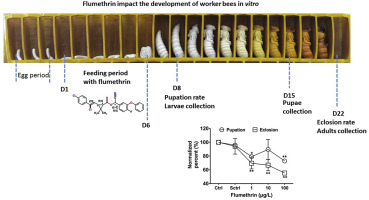当前位置:
X-MOL 学术
›
Ecotox. Environ. Saf.
›
论文详情
Our official English website, www.x-mol.net, welcomes your
feedback! (Note: you will need to create a separate account there.)
Flumethrin at honey-relevant levels induces physiological stresses to honey bee larvae (Apis mellifera L.) in vitro.
Ecotoxicology and Environmental Safety ( IF 6.2 ) Pub Date : 2019-12-21 , DOI: 10.1016/j.ecoenv.2019.110101 Suzhen Qi 1 , Lizhen Zhu 1 , Donghui Wang 2 , Chen Wang 3 , Xiaofeng Chen 4 , Xiaofeng Xue 1 , Liming Wu 1
Ecotoxicology and Environmental Safety ( IF 6.2 ) Pub Date : 2019-12-21 , DOI: 10.1016/j.ecoenv.2019.110101 Suzhen Qi 1 , Lizhen Zhu 1 , Donghui Wang 2 , Chen Wang 3 , Xiaofeng Chen 4 , Xiaofeng Xue 1 , Liming Wu 1
Affiliation

|
Varroa mites often inflict heavy losses on the global bee industry and there are few effective control options. Among these methods to control mites, pesticides are extensively used as a cheap, easy to use, and high-efficiency control measure. However, bees are sensitive to many pesticides; thus, a balance between losses induced by drugs and maximum benefits are important for beekeeping and risk assessment. In this study, the effects of flumethrin, a pyrethroid miticide used on bee colonies, was evaluated using bee larvae reared in vitro. We found that flumethrin induced significant mortality during larval metamorphosis and adult emergence. After continuous exposure during the larval stage, significant changes were observed in antioxidative enzymes (SOD and CAT), lipid peroxidation (MDA, LPO, and POD), and detoxification enzymes (GSH, GST, and GR) in the late instar larvae before pupation. It is also noteworthy that flumethrin significantly regulated the expression of immune (Basket and Dscam) and developmental (Amems, Amhex10869, Vtg and Mfe) genes in larvae, which influences can also be found in the subsequent pupae and adult stages. These findings indicate that flumethrin itself is toxic to bee larvae and has potential risks during colony development. Bees are important pollinators and the sustainable and healthy development of colonies is the foundation of pollinating success for agricultural production. This study would provide some useful thinking for pesticides application techniques and processes in risk assessment of pesticides to bee larvae, even colony.
中文翻译:

与蜂蜜相关的氟氰菊酯在体外诱导对蜜蜂幼虫(Apis mellifera L.)的生理胁迫。
Varroa螨经常给全球蜂业造成巨大损失,而且几乎没有有效的控制选择。在控制螨虫的这些方法中,农药被广泛用作廉价,易于使用和高效的防治措施。但是,蜜蜂对许多农药敏感。因此,药物引起的损失与最大利益之间的平衡对于养蜂和风险评估很重要。在这项研究中,使用体外培养的蜜蜂幼虫评估了氟虫菊酯(一种拟除虫菊酯的杀螨剂)对蜜蜂群体的作用。我们发现氟氰菊酯在幼虫变态和成年出现期间诱导了显着的死亡率。在幼虫阶段连续暴露后,抗氧化酶(SOD和CAT),脂质过氧化(MDA,LPO和POD)和解毒酶(GSH,GST,化GR前的晚star幼虫中。还值得注意的是,氟氰菊酯显着调节幼虫中免疫(Basket和Dscam)和发育(Amems,Amhex10869,Vtg和Mfe)基因的表达,这种影响也可在随后的p和成年期发现。这些发现表明,氟氰菊酯本身对蜜蜂的幼虫具有毒性,并且在菌落发育过程中具有潜在的风险。蜜蜂是重要的授粉媒介,殖民地的可持续健康发展是成功实现农业生产授粉的基础。这项研究将为农药对蜜蜂幼虫甚至群体的风险评估中的农药应用技术和方法提供一些有用的思路。还值得注意的是,氟氰菊酯显着调节幼虫中免疫(Basket和Dscam)和发育(Amems,Amhex10869,Vtg和Mfe)基因的表达,这种影响也可在随后的p和成年期发现。这些发现表明,氟氰菊酯本身对蜜蜂的幼虫具有毒性,并且在菌落发育过程中具有潜在的风险。蜜蜂是重要的授粉媒介,殖民地的可持续健康发展是成功实现农业生产授粉的基础。这项研究将为农药对蜜蜂幼虫甚至菌落的风险评估中的农药施用技术和方法提供一些有用的思路。还值得注意的是,氟氰菊酯显着调节幼虫中免疫(Basket和Dscam)和发育(Amems,Amhex10869,Vtg和Mfe)基因的表达,这种影响也可在随后的p和成年期发现。这些发现表明,氟氰菊酯本身对蜜蜂的幼虫具有毒性,并且在菌落发育过程中具有潜在的风险。蜜蜂是重要的授粉媒介,殖民地的可持续健康发展是成功实现农业生产授粉的基础。这项研究将为农药对蜜蜂幼虫甚至菌落的风险评估中的农药施用技术和方法提供一些有用的思路。这些发现表明,氟氰菊酯本身对蜜蜂的幼虫具有毒性,并且在菌落发育过程中具有潜在的风险。蜜蜂是重要的授粉媒介,殖民地的可持续健康发展是成功实现农业生产授粉的基础。这项研究将为农药对蜜蜂幼虫甚至群体的风险评估中的农药应用技术和方法提供一些有用的思路。这些发现表明,氟氰菊酯本身对蜜蜂的幼虫具有毒性,并且在菌落发育过程中具有潜在的风险。蜜蜂是重要的授粉媒介,殖民地的可持续健康发展是成功实现农业生产授粉的基础。这项研究将为农药对蜜蜂幼虫甚至菌落的风险评估中的农药施用技术和方法提供一些有用的思路。
更新日期:2019-12-27
中文翻译:

与蜂蜜相关的氟氰菊酯在体外诱导对蜜蜂幼虫(Apis mellifera L.)的生理胁迫。
Varroa螨经常给全球蜂业造成巨大损失,而且几乎没有有效的控制选择。在控制螨虫的这些方法中,农药被广泛用作廉价,易于使用和高效的防治措施。但是,蜜蜂对许多农药敏感。因此,药物引起的损失与最大利益之间的平衡对于养蜂和风险评估很重要。在这项研究中,使用体外培养的蜜蜂幼虫评估了氟虫菊酯(一种拟除虫菊酯的杀螨剂)对蜜蜂群体的作用。我们发现氟氰菊酯在幼虫变态和成年出现期间诱导了显着的死亡率。在幼虫阶段连续暴露后,抗氧化酶(SOD和CAT),脂质过氧化(MDA,LPO和POD)和解毒酶(GSH,GST,化GR前的晚star幼虫中。还值得注意的是,氟氰菊酯显着调节幼虫中免疫(Basket和Dscam)和发育(Amems,Amhex10869,Vtg和Mfe)基因的表达,这种影响也可在随后的p和成年期发现。这些发现表明,氟氰菊酯本身对蜜蜂的幼虫具有毒性,并且在菌落发育过程中具有潜在的风险。蜜蜂是重要的授粉媒介,殖民地的可持续健康发展是成功实现农业生产授粉的基础。这项研究将为农药对蜜蜂幼虫甚至群体的风险评估中的农药应用技术和方法提供一些有用的思路。还值得注意的是,氟氰菊酯显着调节幼虫中免疫(Basket和Dscam)和发育(Amems,Amhex10869,Vtg和Mfe)基因的表达,这种影响也可在随后的p和成年期发现。这些发现表明,氟氰菊酯本身对蜜蜂的幼虫具有毒性,并且在菌落发育过程中具有潜在的风险。蜜蜂是重要的授粉媒介,殖民地的可持续健康发展是成功实现农业生产授粉的基础。这项研究将为农药对蜜蜂幼虫甚至菌落的风险评估中的农药施用技术和方法提供一些有用的思路。还值得注意的是,氟氰菊酯显着调节幼虫中免疫(Basket和Dscam)和发育(Amems,Amhex10869,Vtg和Mfe)基因的表达,这种影响也可在随后的p和成年期发现。这些发现表明,氟氰菊酯本身对蜜蜂的幼虫具有毒性,并且在菌落发育过程中具有潜在的风险。蜜蜂是重要的授粉媒介,殖民地的可持续健康发展是成功实现农业生产授粉的基础。这项研究将为农药对蜜蜂幼虫甚至菌落的风险评估中的农药施用技术和方法提供一些有用的思路。这些发现表明,氟氰菊酯本身对蜜蜂的幼虫具有毒性,并且在菌落发育过程中具有潜在的风险。蜜蜂是重要的授粉媒介,殖民地的可持续健康发展是成功实现农业生产授粉的基础。这项研究将为农药对蜜蜂幼虫甚至群体的风险评估中的农药应用技术和方法提供一些有用的思路。这些发现表明,氟氰菊酯本身对蜜蜂的幼虫具有毒性,并且在菌落发育过程中具有潜在的风险。蜜蜂是重要的授粉媒介,殖民地的可持续健康发展是成功实现农业生产授粉的基础。这项研究将为农药对蜜蜂幼虫甚至菌落的风险评估中的农药施用技术和方法提供一些有用的思路。


















































 京公网安备 11010802027423号
京公网安备 11010802027423号